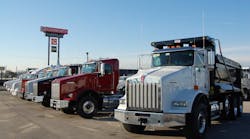Overall, Frost & Sullivan is projecting global truck sales of 2.87 million medium and heavy-duty units in 2014, which is 110,000 thousand more units versus 2013 or some 3.7% growth over last year.
Kar also said, based on his firm’s analysis, that 2014 is the year when North American Class 8 truck sales are projected to reach their “highest levels” compared to the past 6 to 7 years, with Frost & Sullivan predicting Class 8 trucks sales in the region to total 258,000 units, with medium-duty truck sales exceeding 140,000 units.
“In many ways 2014 is poised to be a unique year, and in many other ways this will be a year when several latent forces will be at play bringing about major structural modifications in the global market,” he noted.
Kar’s positive outlook on truck sales for this year mirrors the upbeat vibe expressed at the Mid America Trucking Show back in March. Yet Kar also pointed out that those “latent forces” as he calls them now building up strength are going to reshape the North American market in some new and unique ways.“This is the year when global engine platforms will truly take flight, while global platform strategies of major truck OEMs will experience continued momentum,” Kar (seen at left) explained. “While these and many such news snippets will gain focus, including a steady flow of new truck platform/model introductions – at least 15 new truck models in the medium-heavy category will be launched in 2014 – what will go largely unnoticed will be the rising proliferation of distributed electronics in medium-heavy duty trucks.”
Those “distributed electronics” include OEM-specific telematics systems tied to vehicle diagnostic capabilities design to help truck owners minimize or even prevent downtime due to unexpected issues, such as check engine lights and the like.Stephen Roy, president of North American sales and marketing for Mack Trucks, delved into this very topic in a sit-down meeting with reporters a few months back, with Mack’s brother company, Volvo Trucks, spending a lot of time talking up its remote diagnostics system as well.
Kar believes the development of such technologies is “recognition” on the part of OEMs regarding the change in truck sales models from what he calls a “transactional” to “relational” format, meaning that manufacturers are trying to tie themselves closer to customers for the long term.
That “relational” aspect of truck sales is also going to become more pronounced due to more focus on the part of fleets on total cost of operation or “TCO” metrics, Kar said.
“TCO is becoming a major consideration of truck buyers in both developed and developing markets, with the stage getting set for rapid and profound penetration of connectivity technologies in commercial vehicles,” he explained. “These technologies will not only catalyze mobile resource management but also usher vehicle-to-infrastructure, vehicle-to-vehicle, and related communications aimed at enhancing vehicle uptime, driver satisfaction, and fleet efficiency and safety.”
Kar stressed, too, that 2014 will also be the year in bringing together the amalgamation of what he dubs “green, safe, and smart” as the triad for future commercial vehicle design and development.
“Advanced telematics solutions such as prognostics, green powertrain technologies such as natural gas and advanced diesel engines married with advanced AMTs [automated manual transmissions] plus safety enhancement technologies such as stability control systems will continue gaining global adoption in 2014,” he noted.Kar also thinks 2014 will be a year of strengthening demand for quality used trucks in not only North America and Europe, but also in China.
A noticeable trend in both developed and developing markets is the rising involvement of OEMs in the used truck market, he added.
“OEMs are realizing the need for greater integration of digitization in both new and used truck retailing in gaining more touch points with truck buyers and also for influencing their purchase decisions,” Kar explained.
“Digital retailing initiatives by truck OEMs will range from website based sales optimization to integration of digital marketing within existing dealership models, off-store digitization to lead generation through predictive analytics," he added. "Big data will enable several of these new retailing initiatives.”
Finally, in Kar’s view, while 3.7% growth in global truck sales this year may not sound striking, it is indeed so when placed against a backdrop of the current geopolitical and economic performance going on in the world – such as the ongoing Russian-Ukraine crisis and the dismal gross domestic product (GDP) growth rate of 0.1% recorded by the U.S. economy in the first quarter this year.
“On the surface this may seem a year where the global commercial vehicle is trying to get back its groove,” he said. “But if one drills deeper, one will realize the structural modifications that are already in motion which will make 2014 a year of great relevance in development and introduction of future focused trucks and associated powertrain, chassis, safety, telematics, and regulation compliance technologies.”
No doubt then that this will be a year worth watching closely in terms of truck sales.







